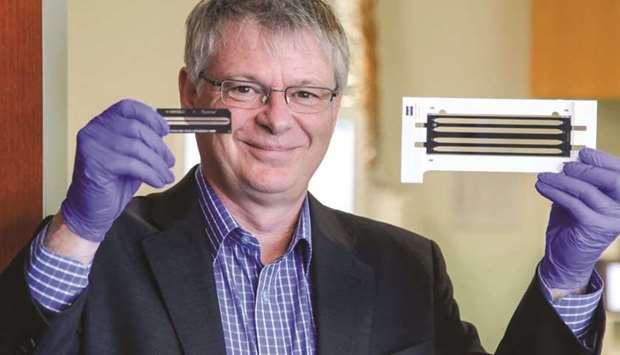Having already set a Guinness world record for delivering a gene-based diagnosis in 19.5 hours, the Rady Children’s Institute for Genomic Medicine now must show that such speedy results are possible for the estimated 80,000 American children in need of such workups each year.
Toward that end, a coalition of researchers led by Dr Stephen Kingsmore, the institute’s president and chief executive, published a study in the respected medical journal Science Translational Medicine that shows similar speed for 10 patients, illustrating that recent advances in genetic sequencing alongside much-faster analysis through artificial intelligence, can deliver results in under 24 hours.
That’s fast enough, authors note, for a doctor to order a genetic workup during their morning rounds and get the results the following morning.
Such speed, even at Rady, has previously been available only in one-off situations that couldn’t be replicated on a grand enough scale to serve thousands of patients per year. But, Kingsmore says, pulling together products from a handful of cutting-edge companies, including Illumina Inc., San Diego’s home-grown sequencing juggernaut, have delivered speed that scales.
“It was very much that we had built a Ferrari, but you couldn’t use it as a daily driver,” Kingsmore said. “This is the daily driver we’ve been striving for.”
From mid-2016 through September 2018, the institute ran four different trials around genetic sequencing of children and infants, enrolling a total of 401 with unexplained symptoms. Most of those, Kingsmore noted, have had their genomes sequenced and analysed at speeds that far exceed what’s available anywhere else, but which are still slower than necessary to deliver a one-day turnaround time.
In order to go faster and to serve more patients simultaneously, Kingsmore said, it is necessary to automate the laborious process of connecting the genetic mutations that sequencing detects with the observed symptoms and signs in each patient’s electronic medical record.
The team has turned to natural language processing and machine learning — two disciplines in the broad world of artificial intelligence — to accomplish that goal.
A trial with 95 children enrolled compared the results of artificial intelligence diagnosis to traditional “manual” analysis by a trained professional and found that the AI solution was as good or better than human competition at this tedious task.
After the trial verified that the AI method was accurate, 10 patients subsequently got the full-bore high-speed workup which, according to study results, was capable of making a diagnosis in a mean time of 20 hours and 10 minutes, less than half the time needed when analysis was performed manually.
It’s important to note that even without the automation steps, Rady’s work flow is faster than can be found pretty much anywhere else. Kingsmore said typical turnaround times for a whole genome sequence and diagnosis is six weeks, with some labs that have adopted rapid sequencing techniques now able to handle the work in two to four weeks.
The data in the paper got the attention of Dr Micheil Innes, a clinical geneticist at Alberta Children’s Hospital in Canada and a professor of medical genetics at the University of Calgary. Though he said that the medical community will definitely need to see such high-speed diagnoses in a larger number of patients for the standard of care to change, it appears that Rady’s results, if they stand up to the hard light of scientific scrutiny, could push medicine closer to the widely held dream of quick gene-driven diagnosis.
The idea of automating away the tedium of sifting through medical records and sequencing results to find the right diagnosis among many possibilities, he said, does have its appeal.
“I don’t think we’re ready to hand all of this work off to automation yet, but if you eliminate some of the time that we currently spend validating results, then that would be significant,” Innes said. “I think that, as a clinician, my time is better spent at the bedside than staring at a computer monitor.”
Kingsmore said that the current workflow his team uses does not eliminate physician oversight. After a diagnosis is selected from many possibilities, a doctor with significant genetic training still needs to spend about an hour reviewing the results to make sure that what the AI has come up with is reasonable according to their medical knowledge. But, he said, doing the same work manually takes a trained and experienced professional 10 hours or more.
The paper’s authors liken the automation involved in Rady’s high-speed analysis method to the autopilot computers commonly used on airplanes. They’re there to eliminate monotony but only under the supervision of experts.
“One hundred six years after the invention of the autopilot, however, two pilots are still employed in cockpits of commercial aircraft. Likewise, a skilled team will still be required to curate the literature and make tough decisions/classifications for the foreseeable future,” the paper states.
The time gains that Rady has realised are not just about artificial intelligence. They also incorporate the latest Illumina sequencers which, Kingsmore said, can reliably analyse five human genomes in less than 16 hours compared to previous equipment that took about 26 hours to process the DNA of just a single patient.
Rady is also using dried blood samples routinely collected from the heels of every newborn to do its analysis, an aspect of the study that fascinated genetic counsellor Erica Ramos. A former Illumina employee now working with an East Coast healthcare system but still living in San Diego, Ramos said the ability to consistently do whole-genome analysis on samples from dried blood spots is new and intriguing.
“The idea of collecting a little drop of blood and being able to run a genome off of that is pretty amazing and could have big implications for the availability of genetic testing,” Ramos said.
Though Rady has obtained its high-speed results in infants and children who often need quick diagnoses due to life-threatening inherited illnesses, especially seizures, there’s no reason why speed couldn’t benefit adults.
Genetics can help determine how a patient’s individual metabolism will handle one drug over another, and that information can sometimes be needed quickly when symptoms present themselves. A heart condition called Fanconi Anemia, for example, can make patients who develop certain blood cancers extremely sensitive to chemotherapy. A quick genetic diagnosis for these patients, she said, could make a big difference in which treatment a doctor chooses.
“The typical turnaround time for testing such as this in many labs is seven to 14 days or more, so having the ability to get results quickly would certainly avoid pain and suffering and severe complications,” Ramos said, noting that the test for Fanoni Anemia is less robust than a whole-genome sequence and thus quicker.
Kingsmore said that the idea of rapid sequencing for adults is not theoretical. An East Coast hospital, he said, has already sent over blood samples from 50 heart patients who could benefit from a quick turnaround. — The San Diego Union-Tribune/TNS

MILESTONE: Dr Stephen Kingsmore at the Rady Children’s Institute for Genomic Medicine Guinness, which set the world record for delivering a gene-based diagnosis in 19.5 hours.


